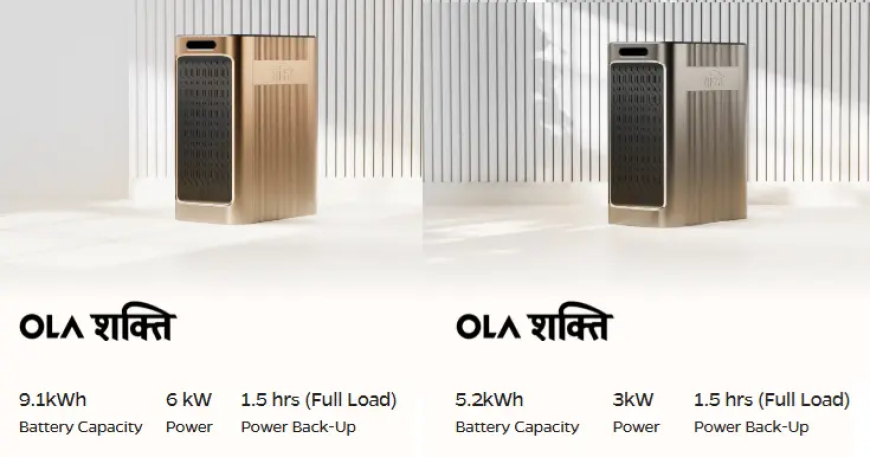Ola Shakti: How Ola Electric’s New Battery System Is Changing Power Backup in India
Meet Ola Shakti — Ola Electric’s first indigenously built residential Battery Energy Storage System. Learn how it works, its features, pricing, and whether it can truly free your home from power worries.

The Story of Ola Shakti — A New Chapter in Energy Independence
Imagine this: It’s a sweltering afternoon in your town. The grid goes down. The fan slows. Lights flicker. The refrigerator hums less. You reach for your old inverter, hoping it still works—but maybe it sputters. That scene is all too familiar for many across India.
Now, shift the scene: the lights stay firm. The AC continues humming. The fridge maintains its chill. Your devices keep going. You barely notice the grid failed. That’s what Ola Electric wants to build with Ola Shakti — a silent, strong backup system for homes, farms, and small businesses.
What is Ola Shakti?
Ola Shakti is Ola Electric’s first residential Battery Energy Storage System (BESS), designed, engineered, and made in India. It runs on the company’s advanced 4680 Bharat Cell technology. Rather than inventing something entirely brand new, it leans into Ola’s existing Gigafactory, its battery cell technology, and its sales/distribution network. It’s a strategic move: making energy storage not just an idea, but something reachable. ETAuto.com+2The Economic Times+2
This system is meant to be portable, modular, and resilient. It’s built to work no matter what: powering ACs, fridges, water pumps, induction cookers — appliances many of us can’t live without. And when the grid fails? Ola Shakti kicks in instantly, with “0 ms changeover time”. No lag. No manual switching. ETAuto.com+2Fortune India+2
Key Features and What Makes It Stand Out
-
Efficiency & Safety: Up to ~98% efficient. Automotive‐grade safety built in. Ola claims zero maintenance cost. Fortune India+1
-
Weather-proof & Durability: Batteries rated IP67, meaning they’re well shielded from dust and water — important when heavy rains or dust storms happen. ETAuto.com+1
-
Voltage Protection: Works across input voltages of about 120V to 290V. That’s especially helpful in places with unstable supply. ETAuto.com+1
-
Smart Controls / Software: Real-time monitoring, app integration, scheduling (for Time-of-Day usage), remote diagnostics, over-the-air updates, backup prioritisation. It’s not just hardware; there’s intelligence built in. Moneycontrol+2Fortune India+2
-
Modularity & Flexibility: Four capacity variants so you can choose what fits your usage and budget — and possibly expand later. ETAuto.com+1
Pricing, Availability & Timeline
Here’s where the plan meets reality:
-
Four versions are being offered for the first 10,000 units:
-
1.5 kWh at ₹29,999
-
3 kWh at ₹55,999
-
5.2 kWh at ₹1,19,999
-
9.1 kWh at ₹1,59,999 ETAuto.com+1
-
-
Pre-reservations have opened at ₹999. India Infoline+1
-
Deliveries are expected to begin around Makar Sankranti 2026 (mid-January). Outlook Business+1
Why This Matters: The Bigger Picture
Power backup solutions in India are not new. Generators, inverters, solar panels, UPS units — many are already in homes. What makes Ola Shakti meaningful is how it ties into several trends at once:
-
Energy Storage Opportunity: Instead of seeing electricity shortage, Ola talks about a “storage opportunity”. As renewables grow, storing that energy becomes critical. Business Standard+1
-
Indigenous Manufacturing: The use of 4680 Bharat Cells and leveraging the Gigafactory means more of the system is made in India—less dependency on imports, more control over cost, supply, and scale. ETAuto.com+1
-
Grid Stability & Backup: Many areas suffer frequent outages, or wide variations in voltage. Ola Shakti’s designed to tackle both — uninterrupted switching, wide input voltage range, protection features.
-
Scaling Clean Energy: As India pushes toward greener energy, solutions like this help homes, small farms, and businesses to be part of the energy transition, not left behind.
What to Watch Out For
Of course, promises are one thing; delivery is another. Based on what’s known, here are some things to keep an eye on:
-
Actual performance under load—will it deliver promised backup time when many devices are running?
-
Long-term reliability: battery degradation over years, especially under harsh climate (heat, humidity).
-
After-sales service and warranties: how effective will maintenance support be across India, especially in smaller towns?
-
Cost beyond introductory pricing: once the first 10,000 units are sold, will prices go up?
Is Ola Shakti Right for You?
If I were you (sitting in Indore, perhaps), here’s how I’d think:
-
If I face frequent power cuts, or unstable grid voltage, Ola Shakti seems very appealing.
-
If I have appliances that can’t be interrupted (fridge, AC, pumps), the instant switching is a big plus.
-
But if my monthly energy need is large, I’d need the higher capacity models — which cost more. I’d check if the cost per kWh stored makes sense compared to alternatives (solar + inverter, or generator).
-
Also check if local climate is harsh (dust, storms) and whether support is near by.
Conclusion
Ola Shakti marks more than just a product launch — it’s a statement. Ola Electric is declaring its shift from being purely just an EV maker to being an energy solutions provider. For many households, particularly in India, it has the potential to turn power backup from an annoyance into something seamless and reliable.
If everything lives up to the claims — safety, durability, backup, cost — this could be a real game-changer. It won’t solve every energy problem, but for many of us, it might make power cuts feel like a thing of the past.







